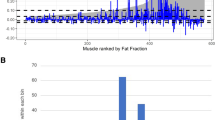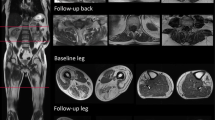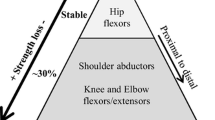Abstract
Only isolated prospective studies have attempted to chart the natural history of facioascapulohumeral muscular dystrophy (FSHD), a benign myopathy with notoriously variable clinical manifestations and progression. This 10-year prospective study was performed to document by simple clinical methods the natural history of 16 patients with moderately advanced FSHD. Limb strength was evaluated by the bedside manual muscle test. Global weakness was documented as a composite average muscle score (AMS). Limb function was evaluated by a non-linear grading system of important functional milestones. A scale of activities of daily living (ADL) was used to assess disability across multiple functional domains in a home environment. Six-monthly evaluations determined a linear deterioration of the mean AMS that reached statistical significance from baseline at the 5-year interval. Half of patients showed a functional decline of the arms by one grade. All patients maintained useful hand function. Three quarters of patients suffered functional decline of the legs, commonly by one grade. All patients remained ambulant. Interval analyses showed a linear deterioration of the mean ADL score that reached statistical significance from baseline at the 5-year interval. Functional deterioration was mostly due to impaired shoulder girdle activities. This study of a relatively homogeneous subgroup of FSHD patients showed a predictable rate of clinical progression in a muscle disease with a notoriously variable clinical presentation and outcome. Natural history data obtained in this study could serve as positive controls for future therapeutic trials in this patient population. The chosen clinical parameters proved useful tools for charting clinical disease progression. Functional tests proved advantageous, because decline was based partly on patient self-reports, thereby improving time and cost effectiveness.



Similar content being viewed by others
References
Appel V, Stewart SS, Smith G, Appel SH (1987) A rating scale for amyotrophic lateral sclerosis: description and preliminary experience. Ann Neurol 22:328–333
Bradley WG (1979) The limb-girdle syndromes. In: Vinken PJ, Bruyn GH (eds) Handbook of clinical neurology, vol 40. Elsevier/North Holland, Amsterdam, pp 433–469
Brooke MH (1990) Introductory comments on disease-specific tests. Muscle Nerve 13(Suppl):S26–S29
Brooke MH (1990) Introductory comments on disease-specific tests. Muscle Nerve 13(Suppl):S38–S39
Brooke MH, Fenichel GM, Griggs RC et al (1989) Duchenne muscular dystrophy: pattern of clinical progression and effects on supportive therapy. Neurology 39:475–481
Brooke MH, Fenichel GM, Griggs RC, Mendell JR, Moxley R, Miller JP, Province MA (1983) Clinical investigation in Duchenne dystrophy: 2. Determination of the “power” of therapeutic trials based on the natural history. Muscle Nerve 6:91–103
Brooke MH, Griggs RC, Mendell JR, Fenichel GM, Shumate JB, Pellegrino RJ (1981) Clinical trial in Duchenne dystrophy. 1. The design of the protocol. Muscle Nerve 4:186–197
Bunch WH, Siegel IM (1993) Scapulothoracic arthrodesis in facioscapulohumeral muscular dystrophy. Review of seventeen procedures with three to twenty-one-year follow-up. J Bone Joint Surg Am 75:372–376
Carroll JE (1979) Facioscapulohumeral and scapuloperoneal syndromes. In: Vinken PJ, Bruyn GH (eds) Handbook of clinical neurology vol 40. Elsevier/North Holland, Amsterdam, pp 415–431
Cuthbert SC, Goodheart GJ (2007) On the reliability and validity of manual muscle testing: a literature review. Chiropr Osteopat 15:4–27
Florence JM, Pandya S, King WM, Robison JD, Baty J, Miller JP, Schierbecker J, Signore LC (1992) Intrarater reliability of manual muscle test (Medical Research Council scale) grades in Duchenne’s muscular dystrophy. Phys Ther 72:115–126
Gresham GE, Phillips TF, Labi ML (1980) ADL status in stroke: relative merits of three standard indices. Arch Phys Med Rehabil 61:355–358
Hasselkus BR, Safrit MJ (1976) Measurement in occupational therapy. Am J Occup Ther 30:429–437
Kasakov V, Rudenko DI (1995) Clinical variability in facioscapulohumeral muscular dystrophy in Russia. Muscle Nerve 18(Suppl 2):S85–S95
Kilmer DD, Abresch RT, McCrory MA, Carter GT, Fowler WM, Johnson ER, McDonald CM (1995) Profiles in neuromuscular diseases: facioscapulohumeral muscular dystrophy. Am J Phys Med Rehabil 74(Suppl):S131–S139
Korner-Bitensky N, Wood-Dauphinee S (1995) Barthel Index information elicited over the telephone. Is it reliable? Am J Phys Med Rehabil 74:9–18
Lue YJ, Chen SS (2000) Strength and functional performance of patients with limb girdle muscular dystrophy. Kaohsiung J Med Sci 16:83–90
Lue YJ, Su CY, Yang RC, Su WL, Lu YM, Lin RF, Chen SS (2006) Development and validation of muscular dystrophy-specific functional rating scale. Clin Rehabil 20:804–817
Lunt PW, Jardine PE, Koch MC, Maynard J, Osborn M, Williams M, Harper PS, Upadhyaya M (1995) Correlation between fragment size at D4F104S1 and age at onset or at wheelchair use, with a possible generational effect, accounts for much phenotypic variation in 4q35-facioscapulohumeral muscular dystrophy (FSHD). Hum Mol Gene 4:951–958
Mahoney FI, Barthel DW (1965) Functional evaluation: the Barthel Index. Md Med J 14:61–65
Marino M, Nicholas JA, Gleim GW, Rosenthal P, Nicholas SJ (1982) The efficacy of manual assessment of muscle strength using a new device. Am J Sports Med 10:360–364
Medical Research Council (1976) Aids to the investigation of peripheral nerve injuries. Her Majesty’s Stationary Office, London
Mendell JR, Florence J (1990) Manual muscle testing. Muscle Nerve 13(Suppl):S16–S20
Mendell JR, Province MA, Moxley RT et al (1987) Clinical investigation of Duchenne muscular dystrophy. A methodology for therapeutic trials based on natural history controls. Arch Neurol 44:808–811
Moxley RT (1990) Functional testing. Muscle Nerve 13(Suppl):S26–S29
Munsat TL (1990) Clinical trials in neuromuscular disease. Muscle Nerve 13 (Suppl):S3–S6 27. Munsat TL (1994) Facioscapulohumeral disease and the scapuloperoneal syndrome. In: Engel AG, Franzini-Armstrong C (eds) Myology. McGraw-Hill, New York, pp 1220–1232
Munsat TL, Andres PL, Finison L, Conlon T, Thibodeau L (1988) The natural history of motorneuron loss in amyotrophic lateral sclerosis. Neurology 38:409–413
Padberg GW (1982) Facioscapulohumeral disease. Doctoral thesis, University of Leiden, Intercontinental Graphics
Padberg GW, Frants RR, Brouner OF, Wijmega C, Bakker E, Sandkuijl LA (1995) Facioscapulohumeral muscular dystrophy in the Dutch Population. Muscle Nerve 18(Suppl 2):S81–S84
Padberg GW, Lunt PW, Koch M, Fardeau M (1991) Diagnostic criteria for facioscapulohumeral dystrophy. Neuromuscul Disord 1:231–234
Personius KE, Pandya S, King W, Tawil R, McDermott MP (1994) Facioscapulo- humeral dystrophy natural history study: standardization of testing procedures and reliability of measurements. Phys Ther 74:253–263
Ricci E, Galluzzi G, Deidda G et al (1999) Progress in the molecular diagnosis of facioscapulohumeral muscular dystrophy and correlation between the number of Kpni repeats at the 4q35 locus and clinical phenotype. Ann Neurol 45:751–757
Shinar D, Gross CR, Bronstein KS et al (1987) Reliability of the activities of daily living scale and its use in telephone interview. Arch Phys Med Rehabil 68:723–728
Tawil R, Figlewicz DA, Griggs RC, Weiffenbach B, the FSH Consortium (1998) Facioscapulohumeral dystrophy. A distinct regional myopathy with a novel molecular pathogenesis. Ann Neurol 43:279–282
Tawil R, Forrester J, Griggs RC, Mendell J, Kissel J, McDermott M, King W, Weiffenbach B, Figlewicz D (1996) Evidence for anticipation and association of deletion size with the severity in facioscapulohumeral muscular dystrophy. The FSH-DY Group. Ann Neurol 39:744–748
Tawil R, van der Maarel SM (2006) Facioscapulohumeral muscular dystrophy. Muscle Nerve 4:1–15
The FSH-DY group (1997) A prospective, quantitative study of the natural history of facioscapulohumeral muscular dystrophy. Neurology 48:38–46
Tindall RSA, Rollins JA, Phillips JT, Greenlee RG, Wells L, Belendink G (1987) Preliminary results of a double blind, randomized, placebo-controlled trial of cyclosporine in myasthenia gravis. N Engl J Med 316:719–724
Twyman RS, Harper GD, Edgar MA (1996) Thoracoscapular fusion in facioscapulohumeral muscular dystrophy: clinical review of a new surgical method. J Shoulder Elbow Surg 5:201–205
Vignos PJ, Spencer GE, Archibald KC (1963) Management of progressive muscular dystrophy in childhood. JAMA 84:89–96
Wadsworth CT, Krishnan R, Sear M, Harrold J, Nielsen DH (1987) Intrarater reliability of manual muscle testing and hand-held dynametric muscle testing. Phys Ther 67:1342–1347
Acknowledgments
This study was supported by the Phyllis Knocker/Bradlow Award from The College of Medicine of South Africa.
Author information
Authors and Affiliations
Corresponding author
Rights and permissions
About this article
Cite this article
Stübgen, JP., Stipp, A. Facioscapulohumeral muscular dystrophy: a prospective study of weakness and functional impairment. J Neurol 257, 1457–1464 (2010). https://doi.org/10.1007/s00415-010-5544-1
Received:
Revised:
Accepted:
Published:
Issue Date:
DOI: https://doi.org/10.1007/s00415-010-5544-1




